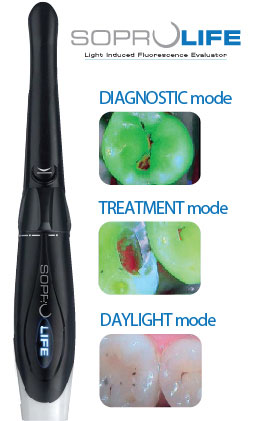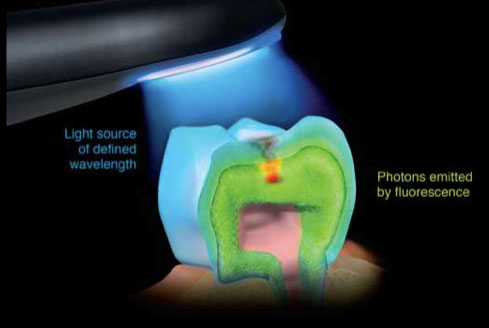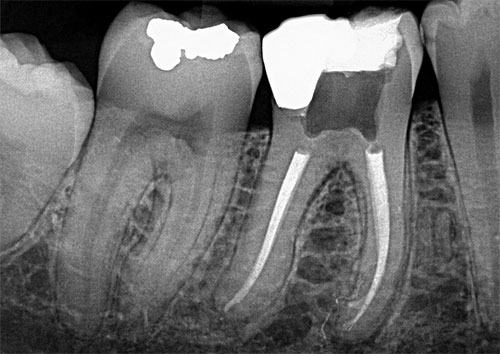A preventive program is a cooperative effort by the patient, dentist, and dental staff to preserve your teeth and supporting structures by preventing the onset, progress, and recurrence of dental diseases and conditions. Preventing dental disease starts at home with good oral hygiene and a balanced diet. It is continued in the dental office by the efforts of your dentist and dental hygienist to promote, restore, and maintain your oral health. Prevention also includes regular dental exams, cleanings, and x-rays. Prevention helps avoid serious and costly dental problems and is the key to having a healthy and beautiful smile.
Dental Exam
A comprehensive dental exam will be performed by Dr. Laurie Schumacher at your initial dental visit. At regular check-up exams will include the following:
• Examination of diagnostic x-rays (radiographs): Essential for detection of decay, tumors, cysts, and bone loss. X-rays also help determine tooth and root positions.
• Oral cancer screening: Check the face, neck, lips, tongue, throat, tissues, and gums for any signs of oral cancer.
• Gum disease evaluation: Check the gums and bone around the teeth for any signs of periodontal disease.
• Examination of tooth decay: All tooth surfaces will be checked for decay with special dental instruments.
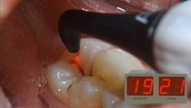 DIAGNOdent Laser Cavity Detection
DIAGNOdent Laser Cavity DetectionThe DIAGNOdent Laser Cavity Detection takes the guesswork out of making a correct treatment decision regarding these teeth. The DIAGNOdent is a small, portable laser unit that can detect cavities on or just below the surfaces of the back teeth, even when they are just beginning. An audible signal alerts the dentist there is a problem and it also provides a numerical readout as to it's approximate size.
Studies show that 50% of caries go undetected* by present diagnostic methods. The DIAGNOdent** aids in diagnosing “hidden” fissure caries more accurately and confidently. Most caries occur in the complex anatomy of the occlusal surfaces, making diagnosis with traditional methods difficult, because the outer tooth surface often appears to be intact.
The DIAGNOdent is a new high tech laser system. It utilizes laser light of a defined wavelength to help detect and quantify demineralized tooth substances without x-ray exposure. This revolutionary new device is easy to use and turns caries detection into a harmless, measurable, more reproducible and exacting procedure.
With DIAGNOdent we are able to make better treatment decisions earlier, whether they call for further “watching” of suspect areas to monitor changes, preventive measures or minimally invasive preparation. Detect the invisible, with the DIAGNOdent.
Please ask us about our new laser scanner cavity detection system!
• Examination of existing restorations: Check current fillings, crowns, etc.
Professional Dental Cleaning
Professional dental cleanings (dental prophylaxis) will include a dental exam and the following:
• Removal of calculus (tartar): Calculus is hardened plaque that has been left on the tooth for some time and is now firmly attached to the tooth surface. Calculus forms above and below the gum line and can only be removed with special dental instruments.
• Removal of plaque: Plaque is a sticky, almost invisible film that forms on the teeth. It is a growing colony of living bacteria, food debris, and saliva. The bacteria produce toxins (poisons) that inflame the gums. This inflammation is the start of periodontal disease!
• Teeth polishing: Remove stain and plaque that is not otherwise removed during tooth brushing and scaling.
Home Care
A beautiful, healthy smile that lasts a lifetime is our ultimate goal when treating patients. Your personal home care plays an important role in achieving that goal. Your personal home care starts by eating balanced meals, reducing the number of snacks you eat, and correctly using the various dental aids that help control the plaque and bacteria that cause dental disease.
Tooth brushing - Brush your teeth at least twice a day (especially before going to bed at night) with an ADA approved soft or extra soft bristle brush and toothpaste. Electric toothbrushes are also recommended.
1. Place the brush at a 45 degree angle to the gums and gently brush using a small, circular motion, ensuring that you always feel the bristles on the gums.
2. Brush the outer, inner, and biting surfaces of each tooth.
3. Use the tip of the brush to clean the inside of the front teeth.
4.Brush your tongue to remove bacteria and freshen your breath.
Flossing - Daily flossing is the best way to clean between the teeth and under the gumline. Flossing not only helps clean these spaces, it disrupts plaque colonies from building up, preventing damage to the gums, teeth, and bone.
1. Take 12-16 inches (30-40cm) of dental floss and wrap it around your middle fingers, leaving about 2 inches (5cm) of floss between the hands.
2. Using your thumbs and forefingers to guide the floss, gently insert the floss between teeth using a sawing motion.
3. Curve the floss into a "C" shape around each tooth and under the gumline. Gently move the floss up and down, cleaning the side of each tooth.
Floss holders are recommended if you have difficulty using conventional floss.
Waterpik® - A powerful miniature pump sends a pulsating jet of water through a plastic syringe-like tip to clean the teeth (sweeping away debris from over, around and between teeth, and under the gumline) and stimulate the gum tissues. The Waterpik is effective in orthodontic (braces) and periodontic (gum disease) patients, as well as patients with crown and bridge work.

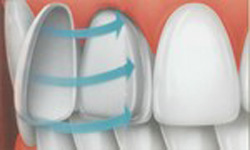 Veneers are thin, custom-made shells crafted of tooth-colored materials designed to cover the front side of teeth. They're made by a dental technician, usually in a dental lab, working from a model provided by your dentist.
Veneers are thin, custom-made shells crafted of tooth-colored materials designed to cover the front side of teeth. They're made by a dental technician, usually in a dental lab, working from a model provided by your dentist.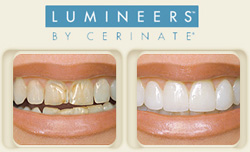 LUMINEERS® BY CERINATE® are porcelain veneers that offer the painless way to a permanently whiter and perfectly aligned smile. Your LUMINEERS dentist can apply these contact lens-thin "smile shapers" to teeth without any grinding or shaving, transforming teeth into a naturally beautiful smile that looks perfect for every individual. LUMINEERS can even be placed over existing crown or bridgework without having to replace them.
LUMINEERS® BY CERINATE® are porcelain veneers that offer the painless way to a permanently whiter and perfectly aligned smile. Your LUMINEERS dentist can apply these contact lens-thin "smile shapers" to teeth without any grinding or shaving, transforming teeth into a naturally beautiful smile that looks perfect for every individual. LUMINEERS can even be placed over existing crown or bridgework without having to replace them.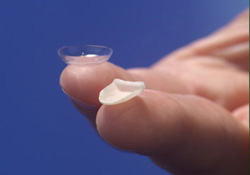 LUMINEERS can only be made from patented Cerinate porcelain unavailable anywhere other than the Cerinate Smile Design Studio. In just 2-3 visits to your LUMINEERS dentist, you can have a custom-made smile that is clinically proven to last over 20 years - and it is completely reversible since your natural tooth structure is still intact! Get your perfect smile today!
LUMINEERS can only be made from patented Cerinate porcelain unavailable anywhere other than the Cerinate Smile Design Studio. In just 2-3 visits to your LUMINEERS dentist, you can have a custom-made smile that is clinically proven to last over 20 years - and it is completely reversible since your natural tooth structure is still intact! Get your perfect smile today!
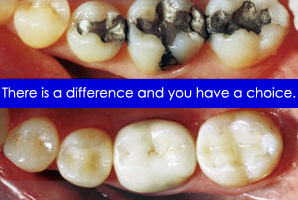 Today, more patients ask their dentists about white fillings because they want their teeth to look natural when they laugh, talk and smile. White fillings, also called composite fillings, are made from tooth-colored materials that restore the natural appearance of a decayed or previously filled tooth. Because they blend well with tooth enamel and don't look like fillings, your dentist may recommend them if the teeth to be restored are near the front of your mouth.
Today, more patients ask their dentists about white fillings because they want their teeth to look natural when they laugh, talk and smile. White fillings, also called composite fillings, are made from tooth-colored materials that restore the natural appearance of a decayed or previously filled tooth. Because they blend well with tooth enamel and don't look like fillings, your dentist may recommend them if the teeth to be restored are near the front of your mouth.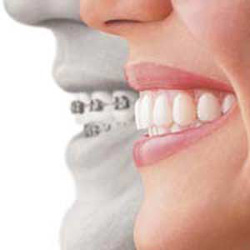
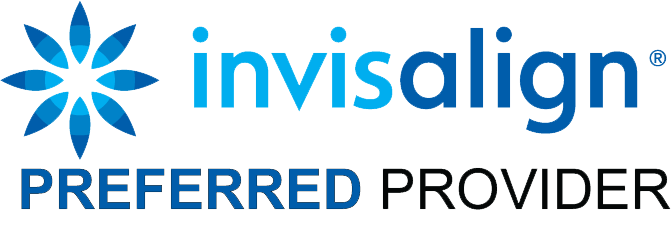

 Your smile is important. It's one of the first things you notice when you meet someone. A whiter, brighter smile is beautiful - it can help you feel better about yourself and make a memorable impression.
Your smile is important. It's one of the first things you notice when you meet someone. A whiter, brighter smile is beautiful - it can help you feel better about yourself and make a memorable impression.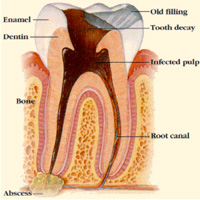 Once upon a time, if you had a tooth with a diseased nerve, you'd probably lose that tooth. Today, with a special dental procedure called a root canal therapy you may save that tooth. Inside each tooth is the pulp which provides nutrients and nerves to the tooth, it runs like a thread down through the root. When the pulp is diseased or injured, the pulp tissue dies. If you don't remove it, your tooth gets infected and you could lose it. After the dentist removes the pulp, the root canal is cleaned and sealed off to protect it. Then your dentist places a crown over the tooth to help make it stronger.
Once upon a time, if you had a tooth with a diseased nerve, you'd probably lose that tooth. Today, with a special dental procedure called a root canal therapy you may save that tooth. Inside each tooth is the pulp which provides nutrients and nerves to the tooth, it runs like a thread down through the root. When the pulp is diseased or injured, the pulp tissue dies. If you don't remove it, your tooth gets infected and you could lose it. After the dentist removes the pulp, the root canal is cleaned and sealed off to protect it. Then your dentist places a crown over the tooth to help make it stronger.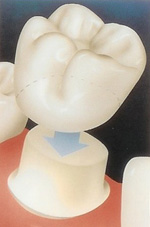
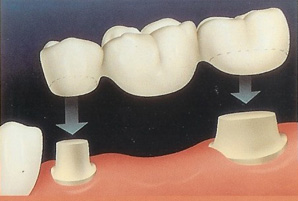
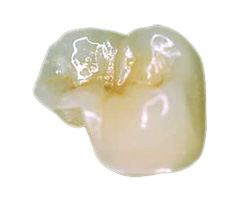 Onlays can be utilized to conservatively repair teeth that have large defective fillings or have been damaged by decay or trauma. Onlays are an ideal alternative to crowns (caps) because less tooth structure is removed in the preparation of onlays. Onlays are essentially identical to inlays with the exception that one or more of the chewing cusps have also been affected and need to be included in the restoration.
Onlays can be utilized to conservatively repair teeth that have large defective fillings or have been damaged by decay or trauma. Onlays are an ideal alternative to crowns (caps) because less tooth structure is removed in the preparation of onlays. Onlays are essentially identical to inlays with the exception that one or more of the chewing cusps have also been affected and need to be included in the restoration.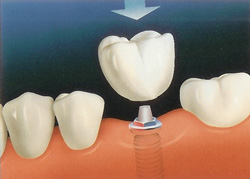 Crowns and conventional bridges or dentures may not be your only options when replacing missing teeth. For some people, dental implants offer a smile that looks and feels very natural. Surgically placed below the gums over a series of appointments, implants fuse to the jawbone and serve as a base for individual replacement teeth, bridges or a denture.
Crowns and conventional bridges or dentures may not be your only options when replacing missing teeth. For some people, dental implants offer a smile that looks and feels very natural. Surgically placed below the gums over a series of appointments, implants fuse to the jawbone and serve as a base for individual replacement teeth, bridges or a denture.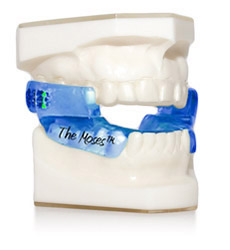 Sleep apnea is a dangerous, potentially life-threatening condition. It is characterized by interruptions of breathing during sleep. The tongue relaxes during sleep and collapses on the airway. These periodic obstructions of breathing during sleep can compromise a good quality of life and are related to other serious medical conditions such as excessive daytime sleepiness, depression, high blood pressure, heart attack and stroke. It occurs in all age groups including children, but is most prevalent in older adults. Sleep apnea is a pause in breathing during sleep that deprives the body of oxygen. Symptoms of sleep apnea include snoring, daytime drowsiness, waking up not refreshed, gasping, choking, sudden awakenings, and other sleeping problems as well.
Sleep apnea is a dangerous, potentially life-threatening condition. It is characterized by interruptions of breathing during sleep. The tongue relaxes during sleep and collapses on the airway. These periodic obstructions of breathing during sleep can compromise a good quality of life and are related to other serious medical conditions such as excessive daytime sleepiness, depression, high blood pressure, heart attack and stroke. It occurs in all age groups including children, but is most prevalent in older adults. Sleep apnea is a pause in breathing during sleep that deprives the body of oxygen. Symptoms of sleep apnea include snoring, daytime drowsiness, waking up not refreshed, gasping, choking, sudden awakenings, and other sleeping problems as well.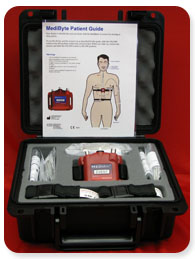 Obstructive sleep apnea results from a complex interaction between nerves, muscles and certain predisposing structural anatomic factors. There is a normal relaxation in muscle tone during sleep but with any combination of the above factors in susceptible individuals, the airway closes. The brain then senses a reduction in oxygen and an increase in carbon dioxide and sends a signal to resume breathing. The patient experiences an arousal from sleep in response to the brain signal, and the muscles of the tongue and pharynx open the airway and breathing resumes. Often this occurs with a loud snort or gasp.
Obstructive sleep apnea results from a complex interaction between nerves, muscles and certain predisposing structural anatomic factors. There is a normal relaxation in muscle tone during sleep but with any combination of the above factors in susceptible individuals, the airway closes. The brain then senses a reduction in oxygen and an increase in carbon dioxide and sends a signal to resume breathing. The patient experiences an arousal from sleep in response to the brain signal, and the muscles of the tongue and pharynx open the airway and breathing resumes. Often this occurs with a loud snort or gasp.